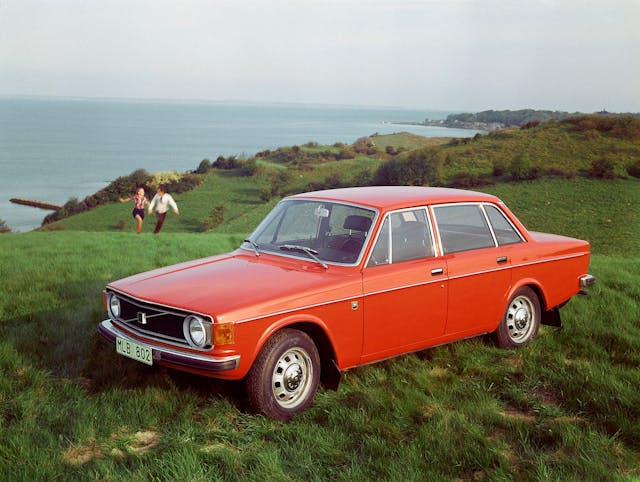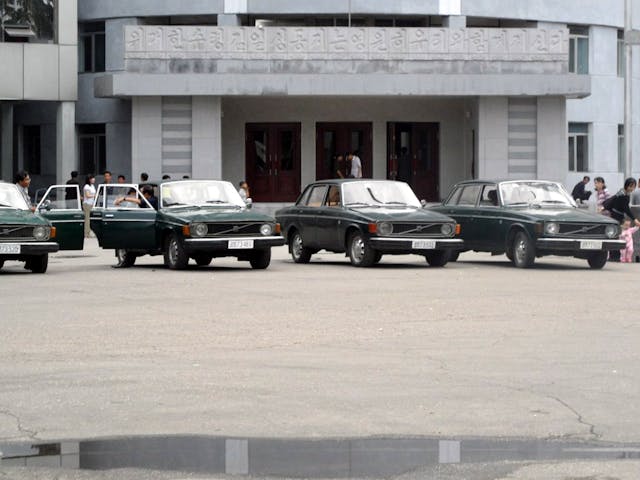How a thousand unpaid-for Volvos created a diplomatic bridge between Sweden and North Korea
The Swedes arrived in Pyongyang in the winter of 1975, but they were well used to the cold. Then in his 20s, Swedish diplomat Erik Cornell was at first excited by the prospect of being one of the only westerners in the hermit kingdom of North Korea. Largely shut to the world since the end of the Korean War, North Korea held an unknown potential. Sweden had gambled, sending industrial equipment and a thousand Volvos, as well as its diplomats. But as of 2023, the country has yet to pay for those Volvos.
The Swedish embassy was a first for the West, and for more than two decades, it was also an only. No other western country bothered to open an embassy in North Korea, and that country’s relations outside of the Soviet Bloc remained strained—as they are today.
Cornell soon discovered that there wasn’t much to do in Pyongyang, other than drive his Volvo around. The country felt empty. But Sweden toughed it out, maintaining the contact even as repeated requests for payment went ignored.

In retrospect, Sweden’s gamble doesn’t seem that absurd. While North Korea was still relying on foreign aid in the 1970s, it’s not like South Korea wasn’t also benefitting from western support. Just look at something like the Genesis G90 as an example of how western aid funneled into South Korea paid off with a strong, industrialized economy. In a different time, betting on North Korea might have paid off, too.
As a Scandinavian country looking to make inroads into untapped markets, Sweden’s efforts in North Korea were full of possibility. Contracts were signed for mining equipment, and for those thousand Volvos. All told, the purchase orders were worth $70 million.
On paper, everything made sense. In the 1970s, Volvo was still expanding into the U.S. market, with advertising that basically made fun of Detroit’s planned obsolescence. Volvos were tough and practical, the copy claimed. I mean, we drive them in Sweden, where the winters and roads are terrible. Just imagine how long a 144DL will last on properly plowed interstates. Why buy a new car every couple of years?

For North Korea, a nation beginning to develop its industrial base, a rugged little Swedish sedan was just the ticket. No wonder Pyongyang was so eager to buy shiny new Volvos by the hundreds. This first purchase would surely lead to more, a thriving Korean-Swedish partnership where prosperity would lead to better East-West relations.
In some alternative universe, it’s possible that’s exactly what happened, and Kim Jong Un is driving his daughter to riding lessons in an XC90, instead of taking her to watch ICBM launches. In this world, however, Swedish optimism was met with a reality as cold as a Pyongyang winter.
North Korea’s rulers either wouldn’t or simply couldn’t part with the $70M in cash. The first thousand Volvos, a mix of 140-series and the then-new 240-series, were also the last thousand Volvos. They were distributed to those loyal to Kim Jong Il’s ruling party and became a status symbol.

North Korea has never had an abundance of personal automobiles, and it certainly didn’t in the 1970s and 1980s. When limited tourism opened up in the late ’80s, tourists on highly supervised excursions started noticing something odd in the background of the photos they were allowed to take: Everything they were shown was spotlessly clean and well-ordered—a model kingdom—but what’s the deal with all the old Volvos?
Volvo’s American PR team wasn’t making things up when it touted the longevity and durability of Swedish cars. Boxy old Volvos really were built tough, and while parts availability was an obvious challenge in North Korea, the cars just kept going. And Sweden kept asking to be paid for them. Twice a year, the Swedish government sends an invoice to the North Korean government, and twice a year it is simply ignored. The process has an odd formality to it, almost as if it is required etiquette.

With interest, the amount now owed is up to $322M, although some of that is for the mining equipment (which seems to have never been used). Sweden’s chances of being paid for its Volvos are essentially zero, although Volvo itself was reimbursed by the Swedish government long ago.
As the years have progressed, the ubiquity of Volvo 140 sedans in Pyongyang has faded. Even an old Volvo isn’t immortal, and the cars are approaching their 50th birthday. They also seem to not quite hold the status they once did, and are most commonly used as taxicabs and the like.
Hopefully, the North Koreans preserve at least one of these 140s and put it in a museum. As it turns out, they are not just unpaid-for Volvos, but a curious and vital form of car-based diplomacy.

By taking a gamble that didn’t pay off financially, Sweden established a certain level of trust with North Korea that is unmatched by any other western power. The North Koreans see the Swedes as trusted brokers, able to bring both sides of a disagreement together without Pyongyang losing face. Sweden serves as the protecting power in North Korea for the U.S., Canada, and Australia. When a citizen of those countries gets in hot water in North Korea, the Swedes are often able to set up a solution.
This kind of trusted communication between an isolated nuclear power and those it sees as adversaries is invaluable. Viewed in those terms, even the bill for a thousand Volvos is worth letting go.
Or rather, it was probably worth the cost of those Volvos for Sweden to establish a relationship. The bill for the Volvos itself, delivered twice a year, is a gentle reminder. Of course you can trust Sweden, North Korea—you’ve been driving its cars for 50 years.
***
Check out the Hagerty Media homepage so you don’t miss a single story, or better yet, bookmark it. To get our best stories delivered right to your inbox, subscribe to our newsletters.



I know a good repo man.
I wonder if the remaining Volvos are still powered by B18 engines or are they like Coban cars with bits of Volga and Moskvich under the hood
The North Koreans could sell the remaining cars here in the US and probably make enough to make a pretty good dent in the bill for the cars and other equipment…. Volvos are up, right?
I beg to differ with your opinion on old Volvo’s immortality. My wife and I just got back from an ice cream run in our 144S.
Interesting story. Not a shocker that the deal with North Korea went as well as it did.
Good story, except for using words like ‘bought’, etc. My Grandpa always told me “It’s not a sale until you get paid”.
I suspect the NKs see the Swedes more as suckers than “trusted brokers.”
I agree with Ken “sucker”
I’m no diplomat but but accounts make for good friends.
I used to own a 1965 volvo 122s. It was a reliable car. Parts at the time were pricey based on my youth and lack of income
“In a different time, betting on North Korea might have paid off, too.”
No, no it wouldn’t. Unless that different time involved there never being a communist North Korea in the first place.
“The North Koreans see the Swedes as trusted brokers,”
Or suckers…. because they’re the only western country to give Lil Kim any veneer of respectability.